ARCHITECTURAL PROJECTS
HOMMAGES
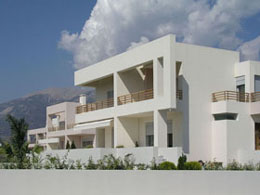
24 March, 2008
deltArCHI
Panos Dragonas and Varvara Christopoulou have been working together since 1998. In 2001, they founded their office which is now known as deltArCHI.
(Presentation of architectural work & Interview to greekarchitects.gr)
Their work has been distinguished in 9 architectural competitions (two first prizes). Their projects have been presented in international and Greek architectural reviews such as L' architecture d' aujourd' hui, Archi, Blueprint, Stavba, Bauwelt, Architecture in Greece, Domes and at numerous architectural exhibitions. DeltArCHI's work is the result of a multifaceted approach to environmental and cultural issues. Their activities are mostly based on research, writing and teaching and assimilate knowledge and experiences form various disciplines.
Interview to greekarchitects.gr
Q: Architectural design is the result of a ceaseless self-examination, which constitutes an action-reaction force pair with the external incentives of an architect, in a course that constantly elaborates through research.
In the context of this challenging procedure, a lot of basic definitions and axioms are reconsidered so that new design opportunities can occur.
As you have covered some kilometers of a course, it would be really interesting to tell us about the basic principles that rule your projects from their beginning to the end.
A: An architect has indeed to cover many kilometers, as you say, in order to talk about basic principles in his work. The difficulty does not lie so much on the understanding of his work, but rather on the evaluation of the work taking in mind the particular conditions that it was created in. The difficulty is intensified under unstable and varying conditions, as it happens now. The functional and cultural demands are rapidly changing nowadays. A home cinema has taken the place of the old fireplace. Second Life has substituted the traditional public spaces of the city. The leisure activities of a beach have moved to urban spas in the basement of new department stores. In times of uncertainty, as in our times, the investigation of the varying factors has the same significance as the expression of the basic design principles.
Our work deals with contemporary issues of the Greek city and landscape, such as the apartment buildings, the vacation houses and the urban public spaces. Our approach to the urban and natural landscape is pragmatic with no regard for the myths, the stereotypes and the preoccupations of the past. From our point of view, the Greek city is a vivid and dynamic urban environment brimful of interesting contradictions. From our point of view, the Mediterranean landscape is a zone of natural phenomena that offers rich sensorial experiences. The investigation of the qualities of both the urban and natural landscape establishes a starting point for innovative approaches in architectural design.
Despite the social, technological and cultural progress, we still consider architecture as an experience of space, perceived through the human body and gaze. The needs, the media and the models may have changed, but the basic elements remain the same: The geometry of space -whether Cartesian or organic- the movement in space -whether it is called "architectural promenade" or walking- and the light - whether this is the bright light of Attica or the varying metropolitan nightlight- remain the essential components of architectural design today. We believe that the challenge of our times is not the invention of a new reality but the evolution of these particular qualities according to the 21st century conditions.
Q: You have entered a lot of Pan-Hellenic and international architectural competitions and many of your entries have been distinguished. Is this a procedure of substantial communication and development of architectural work or a platform for promotion?
A: Architectural competitions have two main objectives: The first one is to select the right architect for the implementation of a project. The second one is to generate and exchange interesting ideas for important issues of architectural design. In most countries of this world, where architectural competitions are held, these two objectives are achieved to some extent. This has ceased to happen in Greece during the last years. There is a shortage of implemented competition awards and a limited interest in exchanging ideas for the competition entries. Publicity focuses only on the first prizes of a few architectural competitions that occasionally attain the attention of the media.
There are three categories of architects that participate in competitions in Greece today: the young ones who seek the opportunity of gaining exposure, the organized firms in times of low workflow and the romantics who insist, each one for his own reasons, to disregard the crisis. The reasons of the problem are not as simple as it may seem and we shall not refer to them at this point. We want to believe that this is a temporary crisis since the organization of architectural competitions is the best way to produce prestigious architectural projects.
Q: What is the image that you formed of the architectural speech that was articulated by the international architects who visited our country last year and talked with the Greek audience?
A: In the time of Internet and real time information, a lecture by an architect is not as an important event as it was only ten years ago. Today the audience is very well acquainted with the top architects' work. Very often the lectures by top international architects remind us of pop star concerts where the audience knows the lyrics and applauds long and loud his favorite stars. The beginning of the recent lecture series came close to such an exaggeration but fortunately did not reach the level of what has happened in other European cities. In this context, the role of the architect - speaker is getting more difficult. The audience may not be won over by the seductive images, which they are already familiar with. A lecture on architecture is a small show. It is obvious that the co-ordination between architectural images and speech is not a proper way to evaluate an architect. Nevertheless, it may still provide an evidence of the great masters. We realized that by Rem Koolhaas' multifarious speech, who opened last year's series, and Alberto Caempo Baeza's didactic and coherent lecture, that we had the chance to attend recently.
Q: You are co creators of Athens9, a new communication initiative to introduce and analyze architectural issues. Which are your first thoughts and remarks, through your daily dialogue with the public and especially the architects?
A: Athens9 is an experiment with no such precedent in Greece and -as far as we know- and abroad. Through this initiative we have set a sequence of objectives. The first objective is the creation of a network of architects that work on innovative proposals for the Greek city. The second objective is the elaboration of the proposals in contact with the public through the Internet. The third and most important objective is the promotion of these ideas and their repercussion on the development of the city. The challenges are big, and so are the difficulties. At this moment we have managed to create a group of mostly young architects who follow the blog and contribute in its development with their comments. The participation of the broader public is not an easy case, because the blog as a medium is very new and the architectural projects -especially those of large scale- are not easily comprehensible by the non-experts. However, we believe that we have invented an innovative and dynamic way to elaborate and promote architectural projects. Can you imagine the impact that this medium might have on the city, in case that a real project of public interest -as e.g. for the Omonoia Square- was presented through a blog like Athens Update?
next pages -Presentation of architectural work
Presentation of architectural work
A main point of reference in deltArCHI's work is the exploration of the specific qualities that characterize the urban and natural landscape of Greece. Being members of a generation that was born and grown up into the Greek cities and keeps a distance from the ideological and sentimental preoccupations of the past, deltArCHI approach the local conditions realistically and objectively. Revealing the inherent qualities of contemporary Greek landscape is a means to develop innovative architectural proposals which principally focus on the improvement of life quality.
DeltArCHI's work includes buildings, competition entries and theoretical projects that may be examined following three thematic categories:
Juxtaposition to the Greek city
The contemporary Greek city is formless. It is an un-designed, borderless, urban landscape which is characterized by its dynamic development and inherent contradictions. Greek cities may easily absorb and neutralize any attempt of architectural innovation. DeltArCHI's projects attain moments of marginal tension in the urban landscape. Elements of different scale, identifiable geometry and morphological clarity are juxtaposed to the formless urban blocks, the placeless public spaces and the borderless suburbs.
--The Apartment Building at Pagkrati attempts to redefine the typology of the post war Athenian "polykatoikia". The plot forms part of a typical Athenian block that was developed more than twenty years ago. The adaptation to the typological codes of the neighboring buildings was pointless since the construction of a much higher structure was demanded.
The building breaks into separate cubes with different orientations. The typical Athenian balconies are joined in order to shape distinct masses and to make the building distinguishable in the formless townscape. The geometric pattern of the building facilitates the identification of each apartment individually from below. The volumetric composition of the balconies appropriates the irregularity of the Athenian skyline.
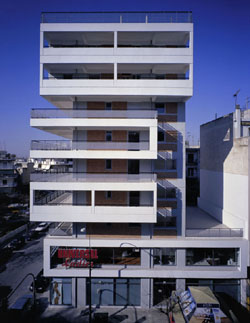
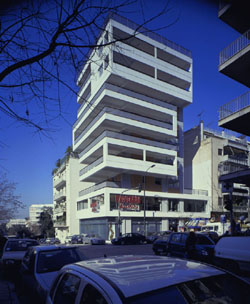
Apartment Building at Pagkrati, Athens
--The Public Square of Markopoulo (1st prize in architectural competition) is an urban space in the center of a rural settlement that is rapidly transformed into a developing small town. Due to the environmental and aesthetic downgrading of the area, the existing square fails to function as a contemporary meeting and leisure place.
Τhe geometrical pattern of the layout was studied thoroughly in order to establish transitional spaces for the movement within the boundaries of the site, taking the form of inclined surfaces. The landscaping includes a linear square (90 X 12 meters) which purposely remains void and with no programme, so that it can host temporary and improvised events.
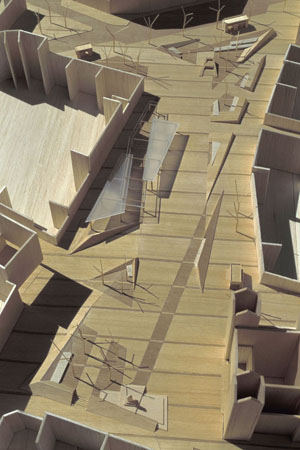
Public Square at Markopoulo (1st prize in architectural competition)
--The Residential Complex at Palaiopanagia is situated in a rapidly developing area west of Nafpaktos. The whole area is borderless and indefinable as in most contemporary suburbs. The ambiguity of street planning and the diversity of architectural production constitute an impromptu space where contemporary rustic slowly substitutes the natural landscape.
The houses are arranged purposely in an order that offers a view to the Rio - Antirrio Bridge. The main intent of the project was the development of a morphologically homogeneous housing complex that attributes a new identity to the area. The four buildings are differentiated by minor morphological and typological variations.
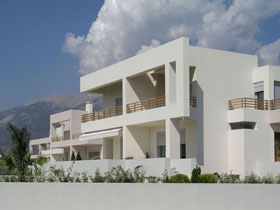
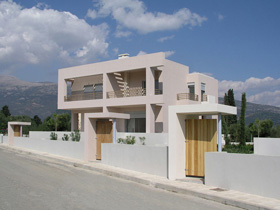
Residential Complex at Palaiopanagia, Nafpaktos
Sensorial experiences in the Mediterranean landscape
The Mediterranean space is a composite phenomenal zone that is characterized by the special way light, water and time are perceived. It is a shelter, a space where city dwellers escape and seek peace of mind and body pleasures. It is a space that has a decisive role to the development of local culture and has substantially influenced local art and poetry. DeltArCHI's work looks into new strategies of intervention that take into consideration the landscape's image and character. The experience of the Mediterranean landscape serves as a starting point to explore new sensorial experiences.
--The dense dissemination of small detached houses has sub-urbanized large parts of the Aegean landscape. The construction of small vacation houses has devastated the natural geometric characteristics of extended coastal areas. This particular issue is explored and a solution is proposed in the project for the Vacation Houses at Skroponeri (honorary mention in architectural competition) on a steep slope site.
Instead of disseminating small units, the sloped area is terraced on its whole. Strong horizontal lines are "engraved" onto the hill following the natural slope. A "new ground" is created in a way that the development respects the existing topology. Accordingly, the vacation houses are arranged under the terraces in such a way that they all offer a view to the Skroponeri bay.
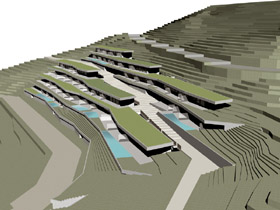
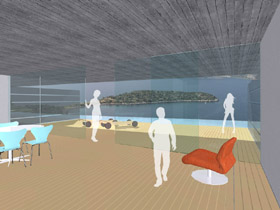
Vacation Houses at Skroponeri (honorary mention in architectural competition)
--The uncontrolled exploitation of the Mediterranean landscape has devastated its distinctive qualities and the invention of urban substitutes has now become a necessity. The creation of new types of spaces for well-being, such as urban spas and resorts, has increased in the last years. The theoretical project "Sous les pavés, la plage" is an architectural interpretation of the characteristic phenomena of the Mediterranean landscape, located in the space of an urban hotel.
The unbuilt ground of a typical urban block is occupied by an open-air pool. Over the pool, the guestroom wings are molded in sharp relief. The guestrooms are arranged around the unbuilt area in order to encourage optical contact, as it happens on a beach. The unbuilt space constitutes a phenomenal zone where one can perceive: changes of the sunlight on the buildings' surface relief; changes of the artificial lighting in the rooms; changes of the weather at the sky and on the water's surface. The proposal aims to create an "artificial nature", a hotel space that recomposes the experience of a craggy beach into an urban block.
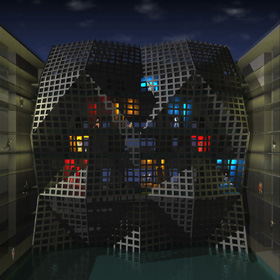
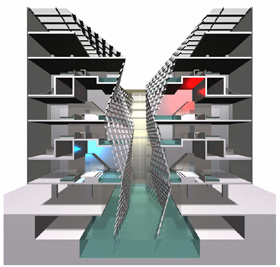
«Sous les pavés, la plage»
--The Europan 8 competition entry, under the title "Piercing Vrbina", raises the issue of re-establishing a small city's identity as a river town. Brežice is a town in Slovenia that lacks public spaces and is surrounded by a dynamic landscape. The size of the project area far exceeds the total surface of the historical center and is traversed by two brooks which often spill high water over the Vrbina plain. The brief demanded for a sustainable and feasible proposal of new public spaces.
The project does not propose a fixed outcome but a design strategy that allows maximum flexibility, indeterminacy and openness. The proposal is based on four independent layers: An array of rectangular lakes that pierce the plain and get the maximum benefit from the programmatic and perceptual interference among city dwellers and natural artifices; the landscape restoration of the two brooks' riverbeds; a system of inclined catwalks that connect the town center with the new spaces even during a flood; crop fields fit for cultivation by agro tourists which occupy the largest part of the site.
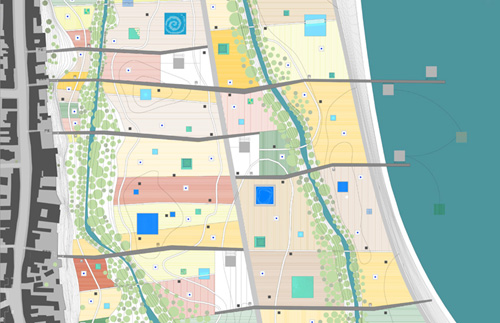
"Piercing Vrbina" (Europan 8 competition entry)
Redefinition of the local
A common ground in the previous thematic categories is the will to redefine elements of local culture according to the demands of 21st century and the processes of globalization. The Greek city and the Mediterranean landscape offer those constituent parts which may ensure continuity with the past and establish a starting point to move onward. DeltArCHI's work keeps a distance from the ideological conflicts of the past, such as "regionalism - internationalism" or "natural landscape - urban space". Local characteristics and values are redefined in an innovative way which is open to a variety of cultural influences and is eager to get "lost in translation" as the new global culture frequently demands.
The project for a Shadow Theater Museum in two adjacent raisin storehouses at Patras (prize in architectural composition after pre-selection) is an architectural interpretation of the spatial qualities that distinguish traditional art.
The figures of the Shadow Theater are exhibited behind backlit fabric while at the same time the visitors move behind perforated metal sheets. A new structure which is wrapped up in copper panels stands at a small distance from the old stone wall. Daylight attracts attention to the new copper roof over the old wall. Artificial lighting shows off the new structure behind the old wall's shadow during nighttime. The choice of copper cladding distinguishes the new construction from the old storehouse masonry and refers to the copper domes of the old churches in Patras.
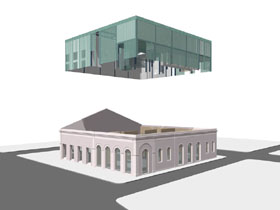
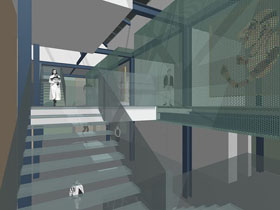
Shadow Theater Museum, Patras (prize in architectural composition after pre-selection)
--"Fournos" Center for Digital Culture is housed in the premises of an old bakery ("fournos" in Greek) in Athens. The chimney and part of the masonry are the most important remnants of the old bakery. A movie theater has been constructed over the old structure.
The proposal for the new "Fournos" responds to the demand for an ambitious program of cultural activities in a structure that is burdened with memories. The new arrangement lays emphasis on the movement of visitors, the instability of new media and the versatility of the premises. An unstable space is proposed, an intelligent cultural infrastructure that may be reprogrammed and reestablish its own identity.
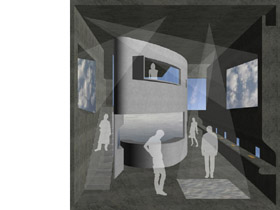
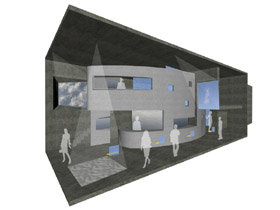
"Fournos" Center for Digital Culture
--DeltArCHI's contribution to the athens9 network focuses on the natural characteristics of Attica's landscape. The theoretical project for the Emergence of Ilisos (an old river in Athens) is a study on the city's history and a design experiment. The project examines the possibilities of restoring the hydrographic network of torrents in east Athens and the benefits that the city would gain of such a venture. It investigates the way that the emergence of a dynamic water system may lead to the restructuring of Athens' public spaces. The project is under development and is presented at the athens9 blog.
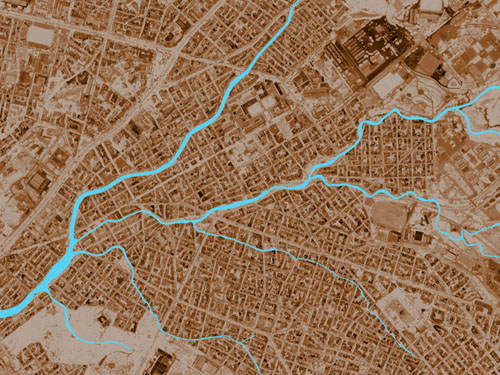
"The emergence of Ilisos"










